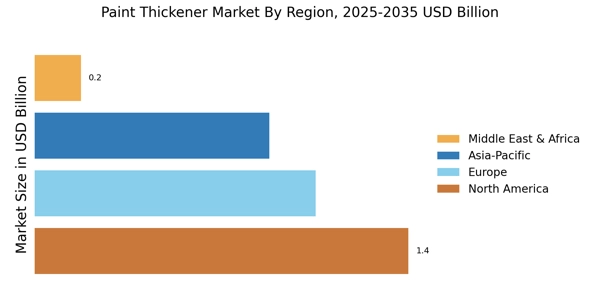Expansion of the Construction Sector
The ongoing expansion of the construction sector serves as a substantial driver for the Paint Thickener Market. With urbanization and infrastructure development on the rise, the demand for paints and coatings is experiencing a notable surge. According to recent data, the construction industry is projected to grow at a compound annual growth rate of over 5% in the coming years. This growth directly correlates with the increased use of paint thickeners, as they enhance the application properties of paints, making them more suitable for various surfaces. As construction projects proliferate, the Paint Thickener Market is poised to benefit from this upward trend.
Rising Demand for Eco-Friendly Products
The increasing consumer preference for eco-friendly and sustainable products is a pivotal driver in the Paint Thickener Market. As environmental awareness grows, manufacturers are compelled to innovate and develop thickeners that are non-toxic and biodegradable. This shift is reflected in the market, where the demand for water-based paints, which often require thickeners, is projected to rise significantly. In fact, the market for water-based paints is expected to reach a valuation of several billion dollars by 2026, indicating a robust growth trajectory. Consequently, the Paint Thickener Market is likely to see a corresponding increase in the demand for sustainable thickeners that align with these eco-conscious trends.
Technological Innovations in Paint Formulations
Technological advancements in paint formulations are significantly influencing the Paint Thickener Market. Innovations such as the development of high-performance thickeners that improve viscosity and stability are becoming increasingly prevalent. These advancements not only enhance the quality of paints but also expand their application range. For instance, the introduction of new polymer-based thickeners has led to improved performance in extreme weather conditions. As manufacturers strive to meet evolving consumer demands, the Paint Thickener Market is likely to witness a surge in the adoption of these innovative products, thereby driving market growth.
Growth in the Automotive and Industrial Coatings Sector
The growth of the automotive and industrial coatings sector is a critical driver for the Paint Thickener Market. As the automotive industry continues to evolve, the demand for high-quality coatings that provide durability and aesthetic appeal is increasing. Paint thickeners play a vital role in achieving the desired consistency and performance of these coatings. Recent statistics indicate that the automotive coatings market is expected to grow at a rate of approximately 4% annually. This growth is likely to propel the Paint Thickener Market, as manufacturers seek to enhance their product offerings to meet the stringent requirements of automotive applications.
Increasing Focus on Aesthetic Appeal in Interior Design
The rising emphasis on aesthetic appeal in interior design is emerging as a significant driver for the Paint Thickener Market. As consumers increasingly prioritize the visual aspects of their living spaces, the demand for decorative paints and coatings is on the rise. This trend is particularly evident in residential and commercial sectors, where unique textures and finishes are sought after. The Paint Thickener Market is likely to benefit from this trend, as thickeners are essential in achieving the desired texture and finish in decorative paints. Market analysts suggest that this focus on aesthetics will continue to drive innovation and growth within the industry.


















Leave a Comment